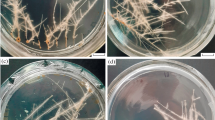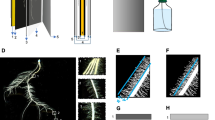Abstract
This paper reports morphological and physiological characteristics of a first root-hairless mutant (RH2) of rice (Oryza sativa L.), which can be useful in advancing knowledge on the role of root hairs in water and nutrient uptake, and genetics of root hairs. The mutant was selected among NaN3 mutagenized progeny of the rice cultivar Oochikara. Microscopic observations showed absence of root hairs in RH2. At the seedling stage, RH2 showed shorter seedling height and shorter roots compared to the wild type variety Oochikara. Because of the differences in seedling growth, all comparisons between Oochikara and RH2 in uptake-related characters were made on the basis of values adjusted by the dry weight of either the shoot or the root. When grown at low water potential in soil, Oochikara and RH2 were similar in shoot water content and transpiration per unit shoot dry weight, and similarly, at low water potential in solution culture, there was no significant difference between Oochikara and RH2 in transpiration per unit shoot dry weight. These results suggest that at the seedling stage, root hairs do not significantly contribute to uptake of water. In solution culture, Oochikara and RH2 did not significantly differ in phosphate uptake per unit root dry weight. This result supports the previous work that root hairs do not contribute to phosphate uptake in solution culture. Regarding to response to plant hormones, RH2 showed a higher level of resistance to two synthetic auxins, 2,4-dichlorophenoxyacetic acid (2,4-D) and 1-naphthaleneacetic acid (NAA) than Oochikara. NAA treatment induced very short root hairs in RH2, suggesting that the absence of root hairs in RH2 may be due to a shortage of endogenous auxin. Genetic analysis showed that the root hairless character in RH2 is inherited as a single recessive gene.
Similar content being viewed by others
References
Bates T R and Lynch J P 1996 Stimulation of root hair elongation in Arabidopsis thaliana by low phosphorus availability. Plant Cell Environ. 19, 529–538.
Bates T R and Lynch J P 2000a Plant growth and phosphorus accumulation of wild type and two root hair mutant of Arabidopsis thaliana (Brassicaceae). Am. J. Bot. 87, 958–963.
Bates T R and Lynch J P 2000b The efficiency of Arabidopsis thaliana (Brassicaceae) root hairs in phosphorus acquisition. Am. J. Bot. 87, 964–970.
Bates T R and Lynch J P 2001 Root hairs confer a competitive advantage under low phosphorus availability. Plant Soil 236, 243–250.
Bernhardt C and Tierney M L 2000 Expression of AtPRP3, a proline-rich structural cell wall protein from Arabidopsis, is regulated by cell-type-specific developmental pathways involved in root hair formation. Plant Physiol. 122, 705–714.
Cernac A, Lincoln C, Lammer D and Estelle M 1997 The SAR1 gene of Arabidopsis acts downstream of the AXR1gene in auxin response. Development 124, 1583–1591.
Dolan L, Duckett C M, Grierson C, Lintead P, Schneider K, Lawson E, Dean C, Poethig S and Roberts K 1994 Clonal relationships and cell patterning in the root epidermis of Arabidopsis. Development 120, 2465–2474.
Gahoonia T S and Nielsen N E 1997 Variation in root hairs of barley cultivars doubled soil phosphorus uptake. Euphytica 98, 183–187.
Gahoonia T S, Nielsen N E, Joshi P A and Jahoor A 2001 A root hairless barley mutant for elucidating genetic of root hairs and phosphorus uptake. Plant Soil 235, 211–219.
Gahoonia T S, Nielsen N E and Lyshede O B 1999 Phosphorus (P) acquisition of cereal cultivars in the field at three levels of P fertilization. Plant Soil 211, 269–281.
Hirata H 1993 Growth and nutrient uptake. In Science of the Rice Plant. Ed. T Matsuo. pp. 197–198. Food and Agriculture Policy reseach Center, Tokyo (in Japanese).
Hofer RM 1996 Origin of the root hairs. In Plant Roots The Hidden Half Second Edition, Rivised and Expanded. Eds. Y Waisel, A Eshel and U Kafkafi. pp. 119–121. Marcel Dekker Inc., New York.
Ichii M 1995 Observation of plant cell and tissues. In Experimental Method for Plant Genetics. Ed. T Taninaka. pp. 56–58. Asakurasyoten, Tokyo (in Japanese).
Ichii M, Kawamura H, Yang L and Taketa S 2000 Characterization of root hair defective mutant in rice. In Breeding Research. Ed. Japanese Society of Breeding. pp. 137. Graduate School of Agricultural and Life Sciences, The University of Tokyo, Tokyo (in Japanese).
Jills S P, Alison C C, Liam D, Keith R and Claire S G 2000 Genetic interactions during root hair morphogenesis in Arabidopsis. Plant Cell 12, 1961–1974.
Ma J F, Goto S, Tamai K and Ichii M 2001 Role of root hairs and lateral roots in silicon uptake by rice. Plant Physiol. 127. 1773–1780.
Masucci J D and Schiefelbein J W 1994 The rhd6 mutation of Arabidopsis thaliana alters root-hair initiation through an auxin-and ethylene-associated process. Plant Physiol. 106, 1335–1346.
Morita S 1987 Morphology and functions of root hair. In Agricultural Technical Compendium. pp. 33–34. Noubunnkyo, Tokyo (in Japanese).
Pitts R J, Cernac A and Estelle M 1998 Auxin and ethylene promote root hair elongation in Arabidopsis. Plant J. 16, 553–560.
Rodoriguez J B, Self J R and Soltanpour P N 1994 Optimal conditions for phosphorus analysis by the ascorbic acid-molybdenum blue method. Soil Sci. Soc. Am. J. 58, 866–870.
Rosene H F 1943 Quantitative measurement of the velocity of water absorption in individual root hairs by a microtechnique. Plant Physiol. 14, 588–607.
Rosene H F and Walthall A M J 1949 Velocities of water absorption by individual root hairs of different species Bot. Gaz. 111, 11–21.
Schnaider K, Mathur J, Boudonck K, Wells B, Dolan L and Roberts K 1998 The ROOT HAIRLESS 1 gene encodes a nuclear protein required for root hair initiation in Arabidopsis. Genes Dev. 12, 2013–2021.
Shiefelbein J W and Somerville C 1990 Genetic control of root hair development in Arabidopsis thaliana. Plant Cell 2, 235–244.
Wen T J and Schnable P S 1994 Analysis of mutants of three genes that influence root hair development in Zea mays (Gramineae) suggest that root hairs are dispensable. Am. J. Bot. 81, 833–842.
Willson A K, Pickett F B, Turner J C and Estelle M 1990 A dominant mutation in Arabidopsis confers resistance to auxin ethylene and abscisic acid. Mol. Gen. Gen. 222, 377–383.
Author information
Authors and Affiliations
Corresponding author
Rights and permissions
About this article
Cite this article
Suzuki, N., Taketa, S. & Ichii, M. Morphological and physiological characteristics of a root-hairless mutant in rice (Oryza sativa L.). Plant and Soil 255, 9–17 (2003). https://doi.org/10.1023/A:1026180318923
Issue Date:
DOI: https://doi.org/10.1023/A:1026180318923




